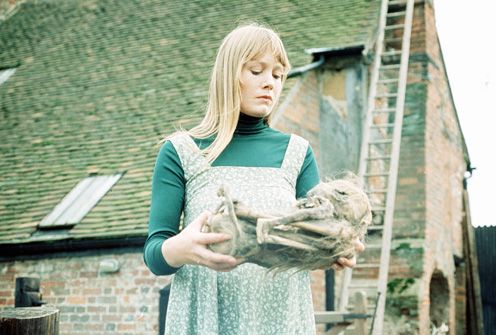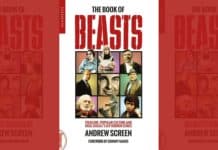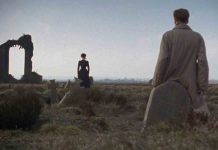CHRIS NEWTON looks back on 1970s classic horror television from Nigel Kneale with Beasts: Baby

Review of Baby Beasts
For people of a certain generation, the ATV logo alone is enough to set them abuzz with nervous anticipation, and one of the former British television company’s greatest offerings was 1976’s ‘Beasts’. Penned and created by Nigel Kneale (the genius behind Quatermass), the series was a six-part horror anthology, with each episode linked by the overall theme of bestial horror. By far the most bizarre and disturbing of which was the fourth episode, ‘Baby’.
The opening shot of the episode shows a lone farmhouse, with no soundtrack save the desolate squawking of birds. This suitably sets the tone of the episode: savage, sparse and barren.
After two workmen, Arthur and Stan, find an abandoned birds nest of addled eggs we are introduced Josephine (Jane Wymark) and Peter Gilkes (Simon MacCorkindale – Hammer House of Horror Fans may recognise him from ‘Visitor from the Grave’), the newlywed couple who have bought the house. Peter has moved to the country for work, where he is proud to finally be a ‘real’ vet, but their cat ‘Muddy’ senses something isn’t right from the off. His incessant mewling is unbearable (interestingly, by this stage in the episode there have probably been more cries from ‘beasts’ than actual dialogue), and as soon as he is freed from his basket he flees from the building, much to Josephine’s dismay. Baby’s dynamic is solidly established in this first scene, the workmen and her husband are all totally dismissive of her concerns and insensitive to her feelings. “Wait ‘til he’s hungry, he’ll show up.” Laughs Stan.
Halfway through demolishing a wall, Arthur and Stan head home for the day, and Peter stubbornly insists on finishing the job to find that the wall is hollow, and seems to have been built to house a large clay urn, sealed with wax. Josephine is wary about opening it but Peter, not for the last time in the episode, ignores her, prising the lid off to reveal a mummified monstrosity that even the vet cannot identify. She describes it as a pig with fur, he says it resembles a lamb with claws. “I’m not sure that it was ever actually born.” He speculates.
Josephine sees this as an ill omen, but Peter laughs it off, insisting that it’s time for a drink, and scoffs at the fact that his pregnant wife won’t even have “just a little one”. “There’s no need to be strictly on the wagon,” he shrugs, “not at this stage.” This isn’t the last of Peter’s lines to suggest that Josephine has miscarried in the past.
Josephine fearful for her unborn child in Beasts Baby
As the events of the episode unfold, Josephine becomes increasingly fearful of the safety of her unborn child, whilst Peter is more interested in schmoozing with his new boss, the bawdy, misogynistic Dick Pummery (T. P. McKena). Around the house she hears strange clawing, scratching noises, the rocking chair in the sitting room rocks of its own accord, and in the fields outside she hears a strange awful sound, somewhere between the braying of cattle and the swarming of bees.
Whilst it’s Jane Wymark’s wonderfully vulnerable portrayal of downtrodden isolation that carries this episode, there’s no denying that Mark Dignam steals the show as the superstitious Arthur, whom Stan mocks for his belief in ‘the fairies.’ Upon seeing the mummified Thing he warns Josephine – in a thick Mummerset accent – “Get shut on it. Get it out of here, get it gone!” It’s one of the most memorable lines of the episode, but things get even creepier when he tells her “It’d have purpose … In them days, they believed they could put harm on a person or place … On lands.”
He goes from creepy to downright disturbing when he slurps his tea and asserts: “That little brute you found, they always had such as those … A thing like that, it’d ‘ave been suckled, you know. Human suckling to set it to work.” It’s a terrifyingly understand performance and, whilst the character is not particularly threatening himself, his grizzled appearance and succinct delivery seem to carry with them decades of dark, esoteric knowledge.
There’s a historic basis for the plot: several hundred years ago, bricking up a dried cat within the walls of a house was thought to ward off evil spirits. A 17th Century cottage was recently unearthed in Barley, near Pendle Hill. A cat’s skeleton was found within in its walls, leading to speculation that the cottage could have been home to one of the Pendle witches.
Arthur’s folkloric insinuations are given some credence by Dick’s anecdotes about their houses’ former occupants, The Jacksons, whose dog farm failed when their prize bitch ‘blew it every time’ and lost her puppies. The surrounding farmland, too, has been unused for years due to cattle sickness and rumours of ‘contagious abortion’. The horror on Josephine’s face is unmistakable when she learns that the Jacksons never had children themselves, but Peter is typically dismissive. “It won’t happen to you. It makes cows abort, but you’re not a cow. You’re beautifully in the club.” Dick insists (although, it has to be said, he treats her with about as much respect of one his farmyard patients). “Vet’s wives. They always know enough to upset them!”
You probably wouldn’t get a husband and wife dynamic like this in modern television, and for good reason, but to dismiss the writing as sexist would be to completely miss the irony. Peter is totally wrong not to take his wife seriously, and his contemptuous attitude toward her only fuels the viewer’s empathy, and the overall feeling of desperation. She tries to make him listen, but he demands that she “stop waffling” when he comes home furious and covered in pig muck.
Golden age of horror television
The mid 70s – early 80s was something of a golden age for this kind of television, with the likes of Thriller and Hammer House of Horror regularly churning out tales of terror, but the last few minutes of this are by far the most twisted and disturbing of them all. Without spoiling it, the finale is a moment of genuine horror, made all the more awful as the credits roll over silence and a single, haunting image. It’s easy to see why the likes of Russell T Davies and Mark Gatiss have cited Beasts as one of the most influential viewing experiences of their youth.
Josephine mentions early in the episode that she herself is originally from the countryside, so it’s little wonder she has more respect for the local superstitions than her city dwelling husband. There’s something fundamental bout Baby’s horror that makes it so timeless. The rural setting, the constant natural struggle of new life Vs. death. It’s a primal connection to nature that makes beasts of us all.
Tell us what you thought of Baby: Beasts in the comments section below!
Read more Beasts episode reviews on Spooky Isles here.
You can buy Beasts, the complete series on DVD, from Amazon.









